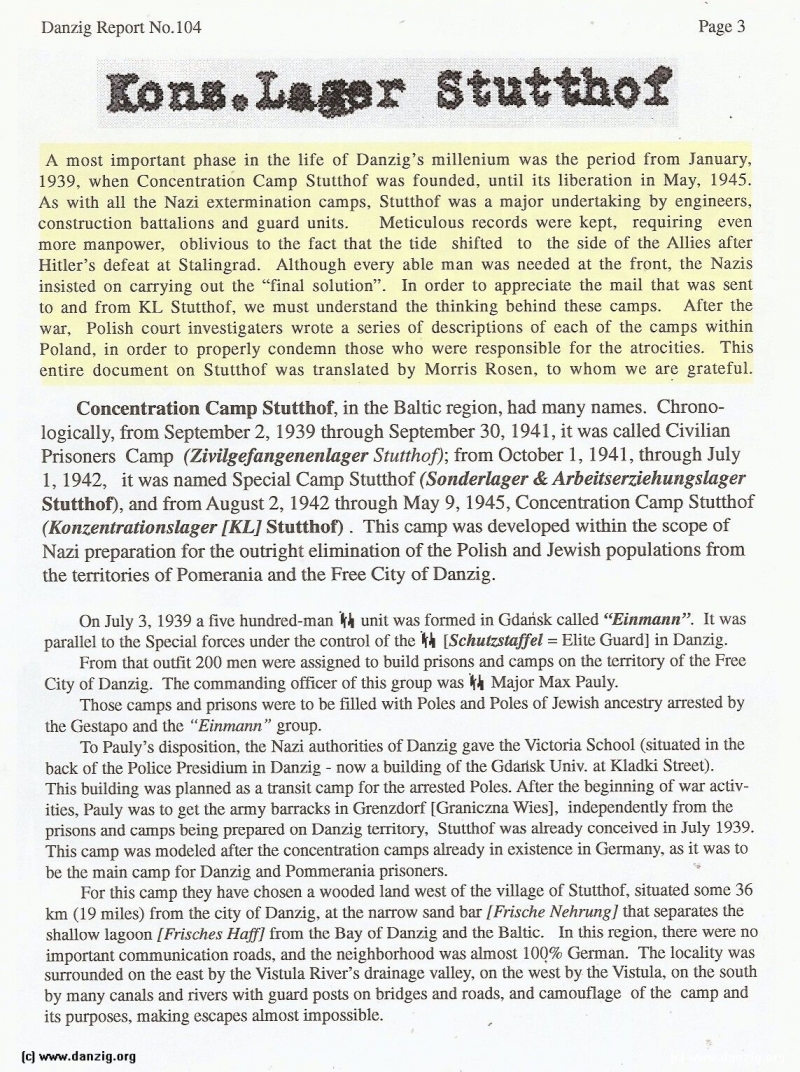
Kons. Lager Stutthof
A most important phase in the life of Danzig’s millenium was the period from January, 1939, when Concentration Camp Stutthof was founded, until its liberation in May, 1945. As with all the Nazi extermination camps, Stutthof was a major undertaking by engineers, construction battalions and guard units. Meticulous records were kept, requiring even more manpower, oblivious to the fact that the tide shifted to the side of the Allies after Hitler’s defeat at Stalingrad. Although every able man was needed at the front, the Nazis insisted on carrying out the “final solution”. In order to appreciate the mail that was sent to and from KL Stutthof, we must understand the thinking behind these camps. After the war, Polish court investigaters wrote a series of descriptions of each of the camps within Poland, in order to properly condemn those who were responsible for the atrocities. This entire document on Stutthof was translated by Morris Rosen, to whom we are grateful.
Concentration Camp Stutthof, in the Baltic region, had many names. Chronol ogically, from September 2, 1939 through September 30, 1941, it was called Civilian Prisoners Camp (Zivilgefangenenlager Stutthof); from October 1, 1941, through July 1, 1942, it was named Special Camp Stutthof (Sonderlager & Arbeitserziehungsiager Stutthof), and from August 2, 1942 through May 9, 1945, Concentration Camp Stutthof (Konzentrationslager [KU Stutthof). This camp was developed within the scope of Nazi preparation for the outright elimination of the Polish and Jewish populations from the territories of Pomerania and the Free City of Danzig.
On July 3, 1939 a five hundred-man IJ unit was formed in Gdañsk called “Einmann”. It was parallel to the Special forces under the control of the 14 [Sckutzstaffel = Elite Guard] in Danzig.
From that outfit 200 men were assigned to build prisons and camps on the territory of the Free City of Danzig. The commanding officer of this group was 1r Major Max Pauly.
Those camps and prisons were to be filled with Poles and Poles of Jewish ancestry arrested by the Gestapo and the “Einmann” group.
To Pauly’s disposition, the Nazi authorities of Danzig gave the Victoria School (situated in the back of the Police Presidium in Danzig - now a building of the Gdansk Univ. at Kladki Street). This building was planned as a transit camp for the arrested Poles. After the beginning of war activities, Pauly was to get the army barracks in Grenzdorf [Graniczna Wies], independently from the prisons and camps being prepared on Danzig territory, Stutthof was already conceived in July 1939. This camp was modeled after the concentration camps already in existence in Germany, as it was to be the main camp for Danzig and Pommerania prisoners.
For this camp they have chosen a wooded land west of the village of Stutthof, situated some 36 km (19 miles) from the city of Danzig, at the narrow sand bar I Frische Nehrungj that separates the shallow lagoon IFrisches HaffJ from the Bay of Danzig and the Baltic. In this region, there were no important communication roads, and the neighborhood was almost 100% German. The locality was surrounded on the east by the Vistula River’s drainage valley, on the west by the Vistula, on the south by many canals and rivers with guard posts on bridges and roads, and camouflage of the camp and its purposes. making escapes almost impossible.
Danzig Report Vol. 1 - Nr. 104 - July - August - September - 1999, Page 3.
Hits: 3511
Added: 25/07/2015
Copyright: 2024 Danzig.org

